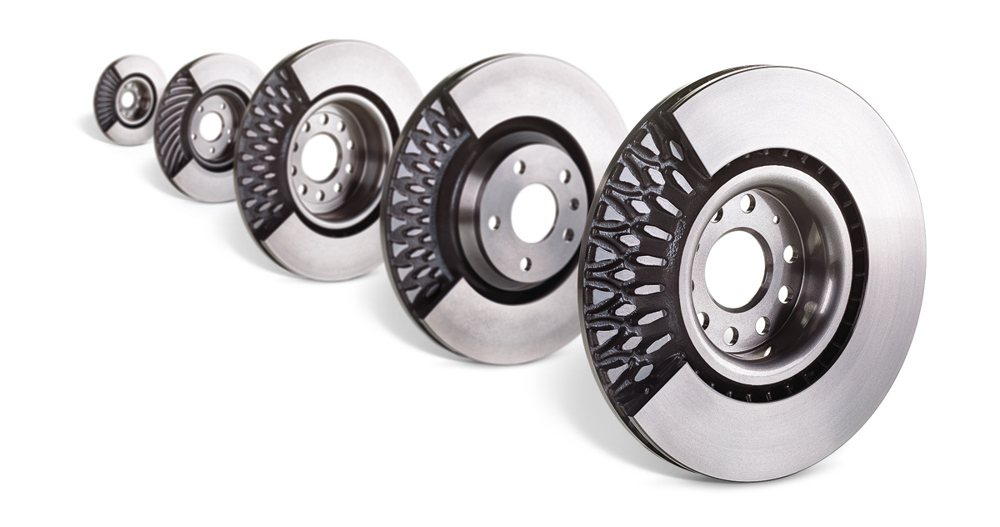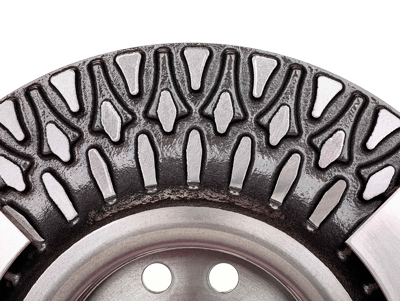Brake discs with vane vs pillar ventilation: the differences
Why use vented discs?
The thermal stresses in a brake disc are extremely intense; in fact, all the energy of the vehicle is transformed into heat, which is generated in the disc/pad interface causing a considerable rise in the local temprrature. Depending on the varying heat conductivity of the disc cast iron and the brake pad friction material, in the majority of cases, more than 80% of the heat generated is absorbed by the brake disc.
So cooling the brake disc is vital for the braking system to function properly. This occurs through air circulation due to the vehicle motion, but most of the movement of air is induced by the revolution of the disc itself.
Depending on the quantity of heat to be dissipated, appropriate solutions need to be implemented to guarantee correct brake operation. The solution that’s generally implemented to increase the heat exchange surface with the air is the use of vented discs, with an appropriate width of the ventilation channel and increasingly efficient ventilation shapes. These ensure improved cooling compared to solid discs, which are therefore used mostly on the rear axle of medium-sized cars or on the front axle of compact and city cars.
Depending on the quantity of heat to be dissipated, appropriate solutions need to be implemented to guarantee correct brake operation. The solution that’s generally implemented to increase the heat exchange surface with the air is the use of vented discs, with an appropriate width of the ventilation channel and increasingly efficient ventilation shapes. These ensure improved cooling compared to solid discs, which are therefore used mostly on the rear axle of medium-sized cars or on the front axle of compact and city cars.
A few years ago, Brembo patented its PVT (Pillar Venting Technology) which, thanks to the shape and distribution of the pillars, manages to create air circulation inside the ventilation chamber, which allows for greater heat removal; what’s more, the position of the pillars is arranged in such a way as to create a good barrier against the formation and propagation of cracks.
Since the Nineties, this type of technology has undergone constant developments, improving in particular the performance in its application to heavy vehicles and vehicles subjected to significant thermal stresses.
The latest news from Brembo is the PVT plus patent which is dedicated to trucks and top-performance cars, which further improves performance during braking, incorporating all the technologies developed previously.

What improvements does PVT ventilation offer compared to conventional ventilation?
The high temperatures that are developed during braking lead to disc wear over time, causing reduced braking performance and excessive brake pad consumption.
Thanks to an enhanced cooling system, PVT ventilation increases resistance to thermal cracks by more than 40%, consequently reducing wear and prolonging the average life of brake discs and pads.
Brembo has continued to improve the quality of its PVT vented discs over time, implementing the T Pillar and Star Pillar patents for the truck market.
The T Pillar solution avoid particles infiltrating the ventilation chamber of truck brake discs, while the Star Pillar solution further enhances resistance to thermal cracks.
The T Pillar solution avoid particles infiltrating the ventilation chamber of truck brake discs, while the Star Pillar solution further enhances resistance to thermal cracks.
Thanks also to the know-how acquired during the development of these patents, it was possible to create the PVT Plus system dedicated to the truck market, as well as to the automotive market, in the premium saloon and high-performance car segments.

What does the PVT Plus solution entail?
The PVT Plus ventilation solution further improves ventilation compared to previous systems, guaranteeing a further increase in durability of brake pads and discs.
The special cross shape of the ventilation pillars, and their layout, provides 30% more resistance to thermal cracking, while also offering significant weight reduction of the disc itself, by up to 10%.
This means several advantages, not just during braking, but also on the overall performance of the vehicle. Indeed, reduced weight means lower consumption levels, fewer CO2 emissions and improved road handling.
What does this mean in terms of driving safety?
To guarantee superior safety performance levels in every braking system, the new PVT Plus ventilation system envisages different geometries for each brake disc, designed specifically with the target vehicle’s specifications in mind.
What about support and maintenance?
In the case of brake discs with curved vanes and directed ventilation, which are handed, the use of the PVT Plus solution allows both discs to be replaced with a single part number which, considering the superior performance levels, guarantees equal if not better performance than brake discs with directed vanes. This means greater ease of assembly and spare parts management.
Er eitthvað annað sem þú vildir spyrja um?
Hafa samband við tækniaðstoð Brembo. Tæknimenn okkar munu hafa samband við þig eins fljótt og auðið er!






